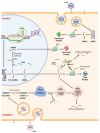Gene Therapy in Amyotrophic Lateral Sclerosis
- PMID: 35805149
- PMCID: PMC9265980
- DOI: 10.3390/cells11132066
Gene Therapy in Amyotrophic Lateral Sclerosis
Abstract
Since the discovery of Cu/Zn superoxide dismutase (SOD1) gene mutation, in 1993, as the first genetic abnormality in amyotrophic lateral sclerosis (ALS), over 50 genes have been identified as either cause or modifier in ALS and ALS/frontotemporal dementia (FTD) spectrum disease. Mutations in C9orf72, SOD1, TAR DNA binding protein 43 (TARDBP), and fused in sarcoma (FUS) genes are the four most common ones. During the last three decades, tremendous effort has been made worldwide to reveal biological pathways underlying the pathogenesis of these gene mutations in ALS/FTD. Accordingly, targeting etiologic genes (i.e., gene therapies) to suppress their toxic effects have been investigated widely. It includes four major strategies: (i) removal or inhibition of abnormal transcribed RNA using microRNA or antisense oligonucleotides (ASOs), (ii) degradation of abnormal mRNA using RNA interference (RNAi), (iii) decrease or inhibition of mutant proteins (e.g., using antibodies against misfolded proteins), and (iv) DNA genome editing with methods such as clustered regularly interspaced short palindromic repeats (CRISPR)/CRISPR-associated protein (CRISPR/Cas). The promising results of these studies have led to the application of some of these strategies into ALS clinical trials, especially for C9orf72 and SOD1. In this paper, we will overview advances in gene therapy in ALS/FTD, focusing on C9orf72, SOD1, TARDBP, and FUS genes.
Keywords: C9orf72; Cu/Zn superoxide dismutase (SOD1); TAR DNA binding protein 43 (TARDBP); amyotrophic lateral sclerosis (ALS); fused in sarcoma (FUS); gene therapy.
Conflict of interest statement
The authors declare no conflict of interest.
Figures

Similar articles
-
Multiple variants in families with amyotrophic lateral sclerosis and frontotemporal dementia related to C9orf72 repeat expansion: further observations on their oligogenic nature.J Neurol. 2017 Jul;264(7):1426-1433. doi: 10.1007/s00415-017-8540-x. Epub 2017 Jun 15. J Neurol. 2017. PMID: 28620717
-
Mutation analysis of SOD1, C9orf72, TARDBP and FUS genes in ethnically-diverse Malaysian patients with amyotrophic lateral sclerosis (ALS).Neurobiol Aging. 2021 Dec;108:200-206. doi: 10.1016/j.neurobiolaging.2021.07.008. Epub 2021 Jul 21. Neurobiol Aging. 2021. PMID: 34404558
-
CRISPR/Cas9-Mediated Gene Correction to Understand ALS.Int J Mol Sci. 2020 May 27;21(11):3801. doi: 10.3390/ijms21113801. Int J Mol Sci. 2020. PMID: 32471232 Free PMC article. Review.
-
From Mouse Models to Human Disease: An Approach for Amyotrophic Lateral Sclerosis.In Vivo. 2018 Sep-Oct;32(5):983-998. doi: 10.21873/invivo.11339. In Vivo. 2018. PMID: 30150420 Free PMC article. Review.
-
[Genetic architecture of amyotrophic lateral sclerosis and frontotemporal dementia : Overlap and differences].Nervenarzt. 2017 Jul;88(7):728-735. doi: 10.1007/s00115-017-0349-4. Nervenarzt. 2017. PMID: 28573364 Review. German.
Cited by
-
Current perspectives on neuromodulation in ALS patients: A systematic review and meta-analysis.PLoS One. 2024 Mar 29;19(3):e0300671. doi: 10.1371/journal.pone.0300671. eCollection 2024. PLoS One. 2024. PMID: 38551974 Free PMC article.
-
Mitochondrial Dynamics in Neurodegenerative Diseases: Unraveling the Role of Fusion and Fission Processes.Int J Mol Sci. 2023 Aug 22;24(17):13033. doi: 10.3390/ijms241713033. Int J Mol Sci. 2023. PMID: 37685840 Free PMC article. Review.
-
Landscape of human organoids: Ideal model in clinics and research.Innovation (Camb). 2024 Apr 1;5(3):100620. doi: 10.1016/j.xinn.2024.100620. eCollection 2024 May 6. Innovation (Camb). 2024. PMID: 38706954 Free PMC article. Review.
-
Behavioral variant frontotemporal dementia associated with GRN and ErbB4 gene mutations: a case report and literature review.BMC Med Genomics. 2024 Jan 30;17(1):43. doi: 10.1186/s12920-024-01819-5. BMC Med Genomics. 2024. PMID: 38291418 Free PMC article. Review.
-
Astrocytes: Dissecting Their Diverse Roles in Amyotrophic Lateral Sclerosis and Frontotemporal Dementia.Cells. 2023 May 23;12(11):1450. doi: 10.3390/cells12111450. Cells. 2023. PMID: 37296571 Free PMC article. Review.
References
-
- Al-Sarraj S., King A., Troakes C., Smith B., Maekawa S., Bodi I., Rogelj B., Al-Chalabi A., Hortobágyi T., Shaw C.E. p62 positive, TDP-43 negative, neuronal cytoplasmic and intranuclear inclusions in the cerebellum and hippocampus define the pathology of C9orf72-linked FTLD and MND/ALS. Acta Neuropathol. 2011;122:691–702. doi: 10.1007/s00401-011-0911-2. - DOI - PubMed
-
- Cooper-Knock J., Hewitt C., Highley J.R., Brockington A., Milano A., Man S., Martindale J., Hartley J., Walsh T., Gelsthorpe C., et al. Clinico-pathological features in amyotrophic lateral sclerosis with expansions in C9ORF72. Brain J. Neurol. 2012;135:751–764. doi: 10.1093/brain/awr365. - DOI - PMC - PubMed
Publication types
MeSH terms
Substances
Grants and funding
LinkOut - more resources
Full Text Sources
Other Literature Sources
Medical
Miscellaneous

